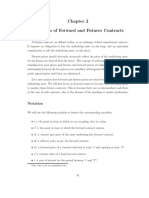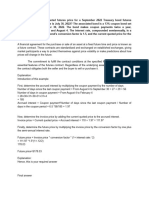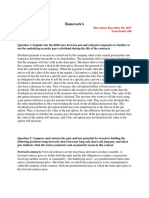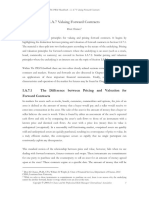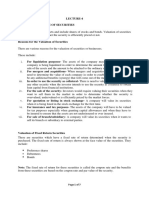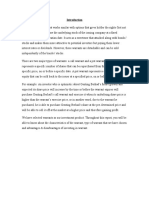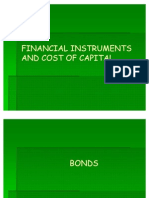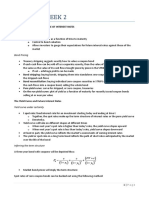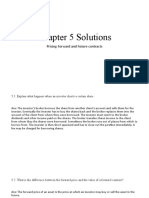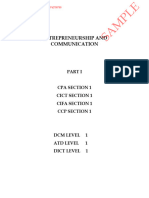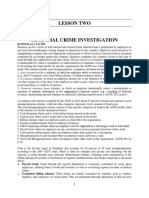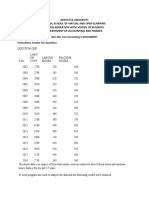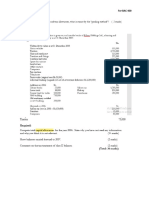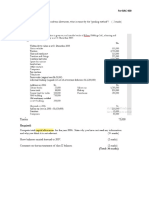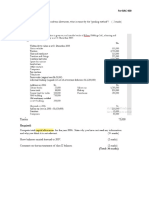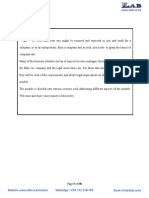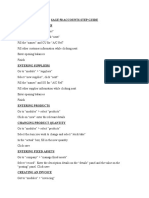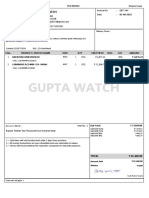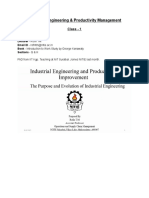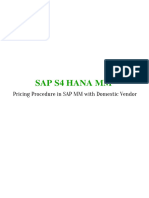Lesson Two-3
Lesson Two-3
Uploaded by
Ruth NyawiraCopyright:
Available Formats
Lesson Two-3
Lesson Two-3
Uploaded by
Ruth NyawiraOriginal Title
Copyright
Available Formats
Share this document
Did you find this document useful?
Is this content inappropriate?
Copyright:
Available Formats
Lesson Two-3
Lesson Two-3
Uploaded by
Ruth NyawiraCopyright:
Available Formats
LESSON TWO
FORWARD CONTRACTS
2.7 PRICING AND VALUATION OF FORWARD CONTRACTS
Are pricing and valuation the same thing? An equity analyst often finds that, a stock is priced
at more or less than its fair market value and uses this conclusion as the basis for a buy or sell
recommendation. In an efficient market, the price of a stock would always equal its value or
the price would quickly converge to the value.
Thus, for all practical purposes, pricing and valuation would be the same thing. In general,
when we speak of the value and price of an asset, we are referring to what that asset is worth
and what it sells for. With respect to certain derivatives, however, value and price take on
slightly different meanings.
Value is what you can sell something for or what you must pay to acquire something. This
applies to stocks, bonds, derivatives, and used cars. Accordingly, valuation is the process of
determining the value of an asset or service. Pricing is a related but different concept; let us
explore what we mean by pricing a forward contract.
A forward contract price is the fixed price or rate at which the transaction scheduled to occur
at expiration will take place. This price is agreed to on the contract initiation date and is
commonly called the forward price or forward rate. Pricing means to determine the forward
price or forward rate. Valuation, however, means to determine the amount of money that one
would need to pay or would expect to receive to engage in the transaction.
The value of a forward contract is determined by the fact that a long forward contract is a
claim on the underlying asset and a commitment to pay the forward price at expiration. The
value of a forward contract is, therefore, the current price of the asset less the present value of
the forward price at expiration. Because no money changes hands at the start, the value of the
forward contract today is zero. The value of a forward contract at expiration is the price of the
underlying asset minus the forward price.
Valuation of a forward contract is important because:
a) It makes good business sense to know the values of future commitments,
b) Accounting rules require that forward contracts be accounted for in income
statements and balance sheets,
c) The value gives a good measure of the credit exposure, and
d) The value can be used to determine the amount of money one party would have to pay
another party to terminate a position.
BAC 309 Financial Derivatives By Matete Page 1
Alternatively, if one already held a position, valuation would mean to determine the
amount of money one would either have to pay or expect to receive in order to get out of the
position.
With today being time 0 and expiration being time T, the time T-0 = T is the number of years
to expiration of the forward contract. Then we more generally write the forward price as
This can be summarized as
Pricing and Valuation Formulas for a Forward Contract can be summarized as:
PRACTICE PROBLEM 1
An investor holds title to an asset worth Kshs 12,572. To raise money for an unrelated
purpose, the investor plans to sell the asset in nine months. The investor is concerned about
uncertainty in the price of the asset at that time. The investor learns about the advantages of
using forward contracts to manage this risk and enters into such a contract to sell the asset in
nine months. The risk-free interest rate is 5.625 percent. Required:
A. Determine the appropriate price the investor could receive in nine months by means of the
forward contract.
B. Suppose the counterparty to the forward contract is willing to engage in such a contract at a
forward price of Shs 14,000. Explain what type of transaction the investor could execute to
take advantage of the situation. Calculate the rate of return (annualized), and explain why
the transaction is attractive.
C. Suppose the forward contract is entered into at the price you computed in Part A. Two
months later, the price of the asset is Shs 11,887.50. The investor would like to evaluate
BAC 309 Financial Derivatives By Matete Page 2
her position with respect to any gain or loss accrued on the forward contract. Determine the
market value of the forward contract at this point in time from the perspective of the
investor in Part A.
D. Determine the value of the forward contract at expiration assuming the contract is entered
into at the price you computed in Part A and the price of the underlying asset is Shs 12,350
at expiration. Explain how the investor did on the overall position of both the asset and
the forward contract in terms of the rate of return.
Suggested solution
In our examples, there were no costs or cash flows associated with holding the underlying
assets. In the specific examples below for equity derivatives, fixed-income and interest rate
derivatives, and currency derivatives, we present cases in which cash flows on the underlying
asset will slightly alter our results. We shall ignore any costs of holding assets. Such costs are
primarily associated with commodities, an asset class that is not addressed by this course.
a) PRICING AND VALUATION OF EQUITY FORWARD CONTRACTS
Equity forward contracts are priced and valued much like the generic contract described
above, with one important additional feature. Many stocks pay dividends, and the effects of
these dividends must be incorporated into the pricing and valuation process. Our concern is
with the dividends that occur over the life of the forward contract, but not with those that may
come after the contract ends. Following standard procedure, we assume that these dividends
are known or are a constant percentage of the stock price.
To obtain the forward price, we compound the stock value to expiration and subtract the
future value of the dividends. Thus, the forward price would be
This formula will give the same answer as the one using the present value of the dividends, as
shown below:
In summary Pricing and Valuation Formulas for Equity Forward Contracts include
BAC 309 Financial Derivatives By Matete Page 3
PRACTICE PROBLEM 2
An asset manager anticipates the receipt of funds in 200 days, which he will use to purchase a
particular stock. The stock he has in mind is currently selling for Shs 6, 250 and will pay ashs
75 dividend in 50 days and another Shs 75 dividend in 140 days. The risk-free rate is 4.2
percent. The manager decides to commit to a future purchase of the stock by going long a
forward contract on the stock.
A. At what price would the manager commit to purchase the stock in 200 days through
a forward contract?
B. Suppose the manager enters into the contract at the price you found in Part A. Now, 75
days later, the stock price is Shs 5,575. Determine the value of the forward contract at this
point.
C. It is now the expiration day, and the stock price is Shs 5,850. Determine the value of the
forward contract at this time.
Suggested solution
b) PRICING AND VALUATION FIXED INCOME AND INTEREST RATE
FORWARDS CONTRACTS
Forward contracts on fixed-income securities are priced and valued in a virtually identical
manner to their equity counterparts. We can use the above formulas if represents the bond
price at time t and represents a coupon paid at time ti. We denote as a coupon bond and
then use notation to draw attention to those coupons that must be included in the forward
contract pricing calculations. We will let represent the bond price at time t, T is
the expiration date of the forward contract, Y is the remaining maturity of the bond on the
forward contract expiration, and (T+Y) is the time to maturity of the bond at the time the
forward contract is initiated. Consider a bond with n coupons to occur before its maturity date.
Converting our formula for a forward contract on a stock into that for a forward contract on a
bond and letting CI be the coupon interest over a specified period of time, we have a forward
price of
BAC 309 Financial Derivatives By Matete Page 4
where PV(CI,O,T) is the present value of the coupon interest over the life of the forward
contract. Alternatively, the forward price can be obtained as
where FV(CI,O,T) is the future value of the coupon interest over the life of the forward
contract.
The value of the forward contract at time t would be
at time t; note that the relevant coupons are only those remaining as of time t until expiration
of the forward contract. As in the case for stock, this formula will reduce to the appropriate
values at time 0 and at expiration. For example, at expiration, no coupons would remain, t=T,
and . At time t =0, the contract is being initiated and has a
zero value, which leads to the formula for F(0,T) above.
In summary Pricing and Valuation Formulas for Fixed Income Forward Contracts
PRACTICE PROBLEM 3
An investor purchased a bond when it was originally issued with a maturity of five years. The
bond pays semiannual coupons of Shs 2,500. It is now 150 days into the life of the bond. The
investor wants to sell the bond the day after its fourth coupon. The first coupon occurs 181
days after issue, the second 365 days, the third 547 days, and the fourth 730 days. At this
point (150 days into the life of the bond), the price is Shs 50,512.50. The bond prices quoted
here include accrued interest.
A). At what price could the owner enter into a forward contract to sell the bond on the day
after its fourth coupon? Note that the owner would receive that fourth coupon. The risk-free
rate is currently 8 percent.
B). Now move forward 365 days. The new risk-free interest rate is 7 percent and the new
price of the bond is Shs 51, 268.75. The counterparty to the forward contract believes that it
has received a gain on the position. Determine the value of the forward contract and the gain
or loss to the counterparty at this time. Note that we have now introduced a new risk-free rate,
because interest rates can obviously change over the life of the bond and any calculations of
the forward contract value must reflect this fact. The new risk-free rate is used instead of the
old rate in the valuation formula.
Suggested
BAC 309 Financial Derivatives By Matete Page 5
Now let us look at the pricing and valuation of FRAs. Previously we used the notations t
and T to represent the time to a given date. The expressions t or T were, respectively, the
number of days to time point t or T, each divided by 365. In the FRA market, contracts are
created with specific day counts. We will use the letter h to refer to the day on which the FRA
expires and the letter g to refer to an arbitrary day prior to expiration. Consider the time line
shown below. We shall initiate an FRA on day 0. The FRA expires on day h.
The rate underlying the FRA is the rate on an m-day Eurodollar deposit. Thus, there are h
days from today until the FRA expiration and h+m days until the maturity date of the
Eurodollar instrument on which the FRA rate is based. The date indicated by g will simply be
a date during the life of the FRA at which we want to determine a value for the FRA.
The rate for m-day LIBOR an day h, Lh(m), will determine the payoff of the FRA. We denote
the fixed rate on the FRA as FRA (O,h,m), which stands for the rate on an FRA established
on day 0, expiring on day h, and based on m-day LIBOR. We shall use a $1 notional principal
for the FRA, which means that at expiration its payoff is
The numerator is the difference between the underlying LIBOR on the expiration day and the
rate agreed on when the contract was initiated, multiplied by the adjustment factor m/360.
Both of these rates are annual rates applied to a Eurodollar deposit of m days; hence,
multiplying by 360 is necessary. The denominator discounts the payoff by the m-day LIBOR
in effect at the time of the payoff.
To derive the formula for pricing an FRA, a specific arbitrage transaction involving
Eurodollars and FRAs is required. We omit the details of this somewhat complex transaction,
but the end result is that the FRA rate is given by the following formula:
This somewhat awkward-looking formula is actually just the formula for a LIBOR forward
rate, given the interest payment conventions in the FRA market. The numerator is the future
value of a Eurodollar deposit of h+m days. The denominator is the future value of a shorter-
term Eurodollar deposit of h days. This ratio is 1 plus a rate; subtracting 1 and multiplying by
360/m annualizes the rate.
BAC 309 Financial Derivatives By Matete Page 6
Consider a 3X9 FRA. This instrument expires in 90 days and is based on 180-day LIBOR.
Thus, the Eurodollar deposit on which the underlying rate is based begins in 90 days and
matures in 270 days. Because we are on day 0, h = 90, m = 180, and h + m = 270. Let the
current rates be
The 90-day rate is 5.6 percent, and the 270-day rate is 6 percent. With h = 90 and m = 180,
using our formula for the FRA rate, we obtain
So to enter into an FRA on day 0, the rate would be 6.11 percent.
As noted, the initial outlay for entering the forward contract is zero. Thus, the initial value is
zero. Later during the life of the contract, its value will rise above or fall below zero. Now let
us determine the value of an FRA during its life. Specifically, we use the notation V,(O,h,m)
to represent the value of an FRA on day g, prior to expiration, which was established on
day 0, expires on day h, and is based on m-day LIBOR. Omitting the derivation, the value
of the FRA will be
This formula looks complicated, but the ideas behind it are actually quite simple. Recall that
we are at day g. The first term on the right-hand side is the present value of $1 received at day
h. The second term is the present value of 1 plus the FRA rate to be received on day h+m, the
maturity date of the underlying Eurodollar time deposit.
Assume that we go long the FRA, and it is 25 days later. We need to assign a value to the
FRA. First note that g=25, h-g=90-25=65, and h+ m-g = 90 +180-25 =245. In other words, we
are 25days into the contract, 65days remain until expiration, and 245days remain until the
maturity of the Eurodollar deposit on which the underlying LIBOR is based. First we need
information about the new term structure. Let
We now use the formula for the value of the FRA to obtain
BAC 309 Financial Derivatives By Matete Page 7
Thus, we went long this FRA on day 0. Then 25 days later, the term structure changes to the
rates used here and the FRA has a value of $0.0026 per $1 notional principal. If the notional
principal is any amount other than $1, we multiply the notional principal by $0.0026 to
obtain the full market value of the FRA.
We have now looked at the pricing and valuation of equity, fixed-income, and interest rate
forward contracts. We summarize the Pricing and Valuation Formulas for Interest Rate
Forward Contracts (FRAs) as
PRACTICE PROBLEM 4
A corporate treasurer needs to hedge the risk of the interest rate on a future transaction. The
risk is associated with the rate on 180-day Euribor in 30 days. The relevant term structure of
Euribor is given as follows:
30-day Euribor 5.75%
210-day Euribor 6.15%
A. State the terminology used to identify the FRA in which the manager is interested.
B. Determine the rate that the company would get on an FRA expiring in 30 days on 180-day
Euribor.
C. Suppose the manager went long this FRA. Now, 20 days later, interest rates have moved
significantly downward to the following:
10-day Euribor 5.45%
190-day Euribor 5.95%
The manager would like to know where the company stands on this FRA transaction.
Determine the market value of the FRA for a €20 million notional principal.
D. On the expiration day, 180-day Euribor is 5.72 percent. Determine the payment made to or
by the company to settle the FRA contract.
Suggested solutions
c) PRICING AND VALUATION OF CURRENCY FORWARD CONTRACTS
BAC 309 Financial Derivatives By Matete Page 8
Foreign currency derivative transactions as well as spot transactions must be handled with
care. The exchange rate can be quoted in terms of units of the domestic currency per unit of
foreign currency, or units of the foreign currency per unit of the domestic currency. we shall
always quote exchange rates in terms of units of the domestic currency per unit of the foreign
currency, which is also called a direct quote. This approach is in keeping with the way in
which other underlying assets are quoted. For example, from the perspective of a U.S.
investor, a stock that sells for $50 is quoted in units of the domestic currency per unit (share)
of stock. Likewise, if the euro exchange rate is quoted as $0.90, then the euro sells for $0.90
per unit, which is one euro. Alternatively, we could quote that $1 sells for 1/$0.90 = €1.111l –
i.e, € 1.1111 per $1; in this case, units of foreign currency per one unit of domestic currency
from the perspective of a U.S. investor. In fact, this type of quote is commonly used and is
called an indirect quote. Taking that approach, however, we would quote the stock price as
1/$50 = 0.02 shares per $1, a very unusual and awkward way to quote a stock price.
.
Finally we summarizes the formulas for pricing and valuation of currency forward
PRACTICE PROBLEM 5
The spot rate for British pounds is $1.76. The U.S. risk-free rate is 5.1 percent, and the U.K.
risk-free rate is 6.2percent; both are compounded annually. One-year forward contracts are
currently quoted at a rate of $1.75.
A) Identify a strategy with which a trader can earn a profit at no risk by engaging in a forward
contract, regardless of her view of the pound’s likely movements. Carefully describe the
transactions the trader would make. Show the rate of return that would be earned from this
transaction. Assume the trader’s domestic currency is U.S. dollars.
B.) Suppose the trader simply shorts the forward contract. It is now one month later. Assume
interest rates are the same, but the spot rate is now $1.72. What is the gain or loss to the
counterparty on the trade?
C.) At expiration, the pound is at $1.69. What is the value of the forward contract to the short
at expiration?
BAC 309 Financial Derivatives By Matete Page 9
Suggested solution
Finally determining the value of a forward contract is important for several reasons. Forward
contracts contain the very real possibility that one of the parties might default. By knowing
the market value, one can determine the amount of money at risk if a counterparty
defaults.
2.8. CREDIT RISK AND FORWARD CONTRACTS
Credit risk in a forward contract arises when the counterparty that owes the greater amount is
unable to pay at expiration or declares bankruptcy prior to expiration. The market value of a
forward contract is a measure of the net amount one party owes the other. Only one party, the
one owing the lesser amount, faces credit risk at any given time. Because the market value
can change from positive to negative, however, the other party has the potential for facing
credit risk at a later date. Counterparties occasionally mark forward contracts to market, with
one party paying the other the current market value; they then reprice the contract to the
current market price or rate.
A distinguishing characteristic of futures contracts is that they are marked to market every
day. In essence, they are forward contracts that are marked to market and repriced daily to
reduce the credit risk.
2.9. THE ROLE OF FORWARD MARKETS
Forward markets play an important role in society, providing a means by which a select
clientele of parties can engage in customized, private, unregulated transactions that commit
them to buying or selling an asset at a later date at an agreed-upon price without paying any
cash at the start. Forward contracts also are a simplified version of both futures and swaps
and, therefore, form a basis for understanding these other derivatives.
Theories of why a forward contract exists.
Allaz and Vila (1993) suggest that there is also a strategic reason (in an imperfect competitive
environment) for the existence of forward trading, that is, forward trading can be used even in
a world without uncertainty. This is due to firms having Stackelberg incentives to anticipate
their production through forward contracts.
BAC 309 Financial Derivatives By Matete Page 10
You might also like
- Direct Tax Corporate Tax Interview QuestionsDocument9 pagesDirect Tax Corporate Tax Interview Questionsanjali aggarwalNo ratings yet
- Luovutuskirja Ajoneuvon Vesikulkuneuvon Omistusoikeuden Siirrosta B124eDocument2 pagesLuovutuskirja Ajoneuvon Vesikulkuneuvon Omistusoikeuden Siirrosta B124eAirsoft100% (1)
- Trust Accounts Full NotesDocument8 pagesTrust Accounts Full NotesRuth Nyawira100% (1)
- Chapter 10 - Forward and Futures Contracts ExamplesDocument65 pagesChapter 10 - Forward and Futures Contracts ExamplesLeon MushiNo ratings yet
- Chapter 5 FM IDocument45 pagesChapter 5 FM Isisaytek69No ratings yet
- Chapter 02 FinalDocument42 pagesChapter 02 FinalprotocusssNo ratings yet
- DerivativesDocument3 pagesDerivativessachin.saroa.1No ratings yet
- Module - Determination of Forward and Future PricesDocument42 pagesModule - Determination of Forward and Future Pricesnikhita1004No ratings yet
- Homework 6Document6 pagesHomework 6LiamNo ratings yet
- Note5 DeterminingForwardPricesDocument10 pagesNote5 DeterminingForwardPricesJeremy PageNo ratings yet
- Term Structure of Interest RatesDocument12 pagesTerm Structure of Interest RatesNikunj ShahNo ratings yet
- Module 7 - Valuing Forward ContractsDocument18 pagesModule 7 - Valuing Forward Contractshexmen2No ratings yet
- 18 Arid 5837 Hassan JavedDocument9 pages18 Arid 5837 Hassan JavedHassan JavedNo ratings yet
- Derivatives - Futures and ForwardsDocument56 pagesDerivatives - Futures and ForwardsSriram VasudevanNo ratings yet
- BFC5935 - Tutorial 7 SolutionsDocument4 pagesBFC5935 - Tutorial 7 SolutionsXue XuNo ratings yet
- Interest-Rate Futures Contracts: Chapter SummaryDocument30 pagesInterest-Rate Futures Contracts: Chapter Summaryasdasd100% (1)
- Valuation of SecuritiesDocument7 pagesValuation of SecuritiesEmmanuelNo ratings yet
- Chapter 11Document4 pagesChapter 11Elaa YaakoubiNo ratings yet
- Introduction To Cross-Border MA - MLMDocument6 pagesIntroduction To Cross-Border MA - MLMJosé Jair Campos ReisNo ratings yet
- (1 Copy) Abmf2093Document10 pages(1 Copy) Abmf2093Cp SeowNo ratings yet
- Chapter Four FMDocument7 pagesChapter Four FMHope GoNo ratings yet
- M M M MDocument46 pagesM M M MajithsubramanianNo ratings yet
- 10. Lecture FinalDocument34 pages10. Lecture FinalPatel FenilNo ratings yet
- IF Unit 5Document7 pagesIF Unit 5Pratheek GowdaNo ratings yet
- Fi CH 3Document54 pagesFi CH 3Gena AlisuuNo ratings yet
- Seminar 8 - AnswersDocument4 pagesSeminar 8 - AnswersSlice LeNo ratings yet
- Bond & Equity ValuationDocument72 pagesBond & Equity ValuationoddjokerNo ratings yet
- Lec 11Document24 pagesLec 11vijay soniNo ratings yet
- Bonds and Long Term LiabilitiesDocument5 pagesBonds and Long Term LiabilitiesDivine CuasayNo ratings yet
- Fins2624 Week 2Document6 pagesFins2624 Week 2Wahaaj RanaNo ratings yet
- Chapter 5 - Pricing Forwards and Futures (S.V.)Document39 pagesChapter 5 - Pricing Forwards and Futures (S.V.)flippy23No ratings yet
- MBF Lecture 9Document27 pagesMBF Lecture 9Nazar WelkakayewNo ratings yet
- Week 7 Learning EbookDocument169 pagesWeek 7 Learning EbookAnniNo ratings yet
- Valuation of Bonds and SharesDocument39 pagesValuation of Bonds and Shareskunalacharya5No ratings yet
- 4.valuation of SecuritiesDocument32 pages4.valuation of Securitiesvarun kumar Verma100% (1)
- UNIT 4 - Describing Fixed Income Securities (Bonds) and DerivativesDocument16 pagesUNIT 4 - Describing Fixed Income Securities (Bonds) and DerivativesCLIVENo ratings yet
- CH3 Derivatives PPDocument61 pagesCH3 Derivatives PPvincenzo21010No ratings yet
- Homework 6Document4 pagesHomework 6Chang Chun-MinNo ratings yet
- CCRA Session 6Document17 pagesCCRA Session 6Amit GuptaNo ratings yet
- Term-to-Maturity Refers To The Number of Years Remaining For The Bond To Mature. Coupon: Coupon Refers To The Periodic Interest Payments That AreDocument5 pagesTerm-to-Maturity Refers To The Number of Years Remaining For The Bond To Mature. Coupon: Coupon Refers To The Periodic Interest Payments That Arehims_rajaNo ratings yet
- Expected Return On Bond Portfolio and Decompose Bond PortfolioDocument12 pagesExpected Return On Bond Portfolio and Decompose Bond Portfolioduc anhNo ratings yet
- chapter 4 ppt inv.tDocument24 pageschapter 4 ppt inv.tanbalaganc.sclasNo ratings yet
- Derivatives and RMDocument35 pagesDerivatives and RMMichael WardNo ratings yet
- Bond Return and ValuationDocument19 pagesBond Return and Valuationoureducation.in100% (2)
- Chapter 5 Solutions Tamzidul IslamDocument18 pagesChapter 5 Solutions Tamzidul IslamTamzidul IslamNo ratings yet
- Chapter - Four: Bond and Stock Valuation and The Cost of CapitalDocument10 pagesChapter - Four: Bond and Stock Valuation and The Cost of CapitalWiz Santa0% (1)
- DerivativesDocument5 pagesDerivativesibong tiriritNo ratings yet
- Float Vcap DocumentDocument9 pagesFloat Vcap DocumentIRSNo ratings yet
- CH 4Document23 pagesCH 4Gizaw BelayNo ratings yet
- Week 7 - Lesson 6 Notes ReceivableDocument17 pagesWeek 7 - Lesson 6 Notes ReceivablefrostNo ratings yet
- Advanced Derivatives Course Chapter 1Document6 pagesAdvanced Derivatives Course Chapter 1api-3841270No ratings yet
- LM06 Pricing and Valuation of Futures Contracts IFT NotesDocument7 pagesLM06 Pricing and Valuation of Futures Contracts IFT NotesRidhtang DuggalNo ratings yet
- Session 6Document26 pagesSession 6tanishk renwalNo ratings yet
- FD ReportDocument16 pagesFD ReportRudresh TrivediNo ratings yet
- DerivativesDocument7 pagesDerivativesSameeja MobileNo ratings yet
- Group 5 - Bond and Stock ValuationDocument56 pagesGroup 5 - Bond and Stock Valuationtuan sonNo ratings yet
- Financial Institutions Management - Chap024Document20 pagesFinancial Institutions Management - Chap024Wendy YipNo ratings yet
- AC 506 Midterm ExamDocument10 pagesAC 506 Midterm ExamJaniña NatividadNo ratings yet
- Bonds ValuationsDocument57 pagesBonds ValuationsarmailgmNo ratings yet
- Levich Ch11 Net Assignment SolutionsDocument16 pagesLevich Ch11 Net Assignment SolutionsNisarg JoshiNo ratings yet
- CFA Level 1: Derivatives and Alternative Investments: CFA level 1, #4From EverandCFA Level 1: Derivatives and Alternative Investments: CFA level 1, #4Rating: 5 out of 5 stars5/5 (1)
- Lecture 3 Information Systems, Organization and StrategyDocument11 pagesLecture 3 Information Systems, Organization and StrategyRuth NyawiraNo ratings yet
- Accounting For Trusts Students NotesDocument12 pagesAccounting For Trusts Students NotesRuth NyawiraNo ratings yet
- Entrepreneurship and Communication SkillsDocument60 pagesEntrepreneurship and Communication SkillsRuth NyawiraNo ratings yet
- Chapter Two-1Document11 pagesChapter Two-1Ruth NyawiraNo ratings yet
- Topic 5 Overvier of Forensic AccountingDocument32 pagesTopic 5 Overvier of Forensic AccountingRuth NyawiraNo ratings yet
- Chapter Five-1Document5 pagesChapter Five-1Ruth NyawiraNo ratings yet
- Bac 404 Assignment April 2020Document4 pagesBac 404 Assignment April 2020Ruth NyawiraNo ratings yet
- Tax Illustration Capital Allowance-1Document2 pagesTax Illustration Capital Allowance-1Ruth NyawiraNo ratings yet
- Activity Based CostingDocument36 pagesActivity Based CostingRuth Nyawira100% (1)
- Administration of Value Added Tax-VatDocument13 pagesAdministration of Value Added Tax-VatRuth NyawiraNo ratings yet
- Tax Illustration Capital Allowance-1Document1 pageTax Illustration Capital Allowance-1Ruth NyawiraNo ratings yet
- Bac 411 Class Illustration Testacy DistributionDocument5 pagesBac 411 Class Illustration Testacy DistributionRuth Nyawira100% (1)
- Tax Illustration Capital Allowance-1Document2 pagesTax Illustration Capital Allowance-1Ruth NyawiraNo ratings yet
- Executors Accounts Illustration Right OneDocument2 pagesExecutors Accounts Illustration Right OneRuth NyawiraNo ratings yet
- Bba 302 Students Notes-1Document79 pagesBba 302 Students Notes-1Ruth NyawiraNo ratings yet
- Tax Illustration Capital Allowance-1Document1 pageTax Illustration Capital Allowance-1Ruth NyawiraNo ratings yet
- Allocation of Joint CostsDocument3 pagesAllocation of Joint CostsRuth NyawiraNo ratings yet
- Allocation of Joint CostsDocument3 pagesAllocation of Joint CostsRuth NyawiraNo ratings yet
- 2017 BMS400 NotesDocument329 pages2017 BMS400 NotesRuth NyawiraNo ratings yet
- Preparation of Published Financial StatementsDocument19 pagesPreparation of Published Financial StatementsRuth Nyawira100% (1)
- Cost Estimation and ForecastingDocument8 pagesCost Estimation and ForecastingRuth NyawiraNo ratings yet
- Bba 401Document95 pagesBba 401Ruth NyawiraNo ratings yet
- Bba 101 Business Law 1 (Lecture Notes)Document99 pagesBba 101 Business Law 1 (Lecture Notes)Ruth Nyawira100% (5)
- Sage 50 Accounts Step Guide Entering CustomersDocument3 pagesSage 50 Accounts Step Guide Entering CustomersRuth NyawiraNo ratings yet
- GST141Document1 pageGST141Ankit KumarNo ratings yet
- Botanical and Floral Design Agency by SlidesgoDocument40 pagesBotanical and Floral Design Agency by SlidesgoTamira VanteciaNo ratings yet
- BDPM PresentationDocument5 pagesBDPM PresentationakashNo ratings yet
- Chemrobotics - Brochure 2.0Document1 pageChemrobotics - Brochure 2.0Vishwanath DasNo ratings yet
- Managing Conflict and The Art of NegotiationhhDocument45 pagesManaging Conflict and The Art of NegotiationhhKamal AldeenNo ratings yet
- IRA Contribution and RolloverDocument4 pagesIRA Contribution and Rolloverja leeNo ratings yet
- JSW Solar v. Czech RepublicDocument141 pagesJSW Solar v. Czech RepublicDana MardelliNo ratings yet
- Quiz Chapter 2Document6 pagesQuiz Chapter 2mahdiNo ratings yet
- Driver Responsibilities ResumeDocument6 pagesDriver Responsibilities Resumebdg8b37x100% (2)
- Business and The SDGsDocument64 pagesBusiness and The SDGsPhuong CRNo ratings yet
- Innovation ManagementDocument17 pagesInnovation ManagementJanesh AtreyNo ratings yet
- PI TranscriptDocument59 pagesPI TranscriptANo ratings yet
- Moment Speed Form For PilecapsDocument22 pagesMoment Speed Form For PilecapsDarren WanNo ratings yet
- Wheat DaliyaDocument24 pagesWheat Daliyagaonmajha.akolaNo ratings yet
- The World Is Flat America and Free Trade: Is Ricardo Still Right?Document8 pagesThe World Is Flat America and Free Trade: Is Ricardo Still Right?Shreya PaiNo ratings yet
- Portfolio Management in Indian Market EditDocument111 pagesPortfolio Management in Indian Market EditChandan SrivastavaNo ratings yet
- Process Improvement Plan TemplateDocument7 pagesProcess Improvement Plan TemplateMrudula V.No ratings yet
- Opcr Fy 2023Document16 pagesOpcr Fy 2023Carla Anica RamosNo ratings yet
- Curriculum Vitae: Subject: Auto Electrician TechnicianDocument2 pagesCurriculum Vitae: Subject: Auto Electrician Technicianbalwinder Singh100% (1)
- Globalization and The Challenges of Public AdmDocument216 pagesGlobalization and The Challenges of Public Admfarhan hashmiNo ratings yet
- Bipin Enterprises: GST Tax InvoiceDocument1 pageBipin Enterprises: GST Tax Invoicebipin enterprisesNo ratings yet
- Industrial Engineering & Productivity ManagementDocument24 pagesIndustrial Engineering & Productivity ManagementSarvesh SrivastavaNo ratings yet
- SAP MM Step by Step Configuration of Pricing Procedure 1696828620Document27 pagesSAP MM Step by Step Configuration of Pricing Procedure 1696828620Susan MihaiNo ratings yet
- SpColumn ManualDocument107 pagesSpColumn ManualJuan Carlos Cruz ENo ratings yet
- BUS 5112-01 - AY2022-T3 Portfolio Activity Unit 1Document4 pagesBUS 5112-01 - AY2022-T3 Portfolio Activity Unit 1Mau MauNo ratings yet
- Amit Dharap: General Manager Samsung India Electronics PVT LTD - INSEADDocument1 pageAmit Dharap: General Manager Samsung India Electronics PVT LTD - INSEADss kkNo ratings yet
- Excel PDFDocument32 pagesExcel PDFXian LitNo ratings yet
- Plant Layout & Piping Design: PL L1 Basic MeduleDocument11 pagesPlant Layout & Piping Design: PL L1 Basic MeduleAhmad Nabil Elsharkawy100% (2)





